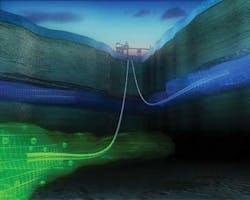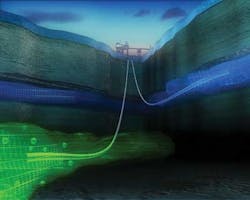In-situ scanning improves flexible riser, flowline health management
John Marsden
Flexlife
A newly developed technology can scan the annulus of flexible risers and flowlines in situ using ultrasonic scanning.
The equipment can determine annulus condition (i.e. flooded or un-flooded) as well as the extent and specific location of flooding. It can accurately determine if the annulus is filled with permeated water or seawater, which can have a significant effect on the service life of dynamic risers.
Once an annulus has water in it, the equipment can scan and measure the wire thickness accurately. This can be done on the site of the breach to inspect for wire thinning or snapped wires, something that has been difficult to do in situ.
The Neptune in use underwater in the North Sea.
The application also can provide information on wire condition for the riser over areas of interest. The data can be applied in fatigue life calculations to eliminate engineering assumptions.
With this capability, operators can know the exact condition of a riser and, if flooded, the wire thickness. It removes many of the risks surrounding flexibles and assists operators in critical decision-making that would otherwise be based on generic assumptions and subsequent calculations. Using live data can extend the lifespan of flexible pipes and reduce the risk of major hydrocarbon leaks and associated environmental, personnel, and production impact.
The technology has been tested and proven in stages, starting with hand-held probes onshore and extending through extensive trials in test tanks. Following onshore testing of the scanning application and results showing armor wire thickness to an accuracy of 0.1 mm (0.004-in.), Flexlife found a delivery partner in AGR Pipetech AS. The latter’s Neptune system is designed to interface with any inspection or work class ROV.
Computer scan showing screen of a flooded riser.
Full offshore testing then was conducted in the Norwegian sector of the North Sea, and gave 100% accurate results. Flexlife currently is working with an operator to further validate the accuracy by scanning the pipes offshore, then recovering and dissecting them to compare results.
Features of the system include a current operating depth to 600 m (1,968 ft) -- deeper water scans are possible with upgraded buoyancy and bottle designs -- and the ability to scan risers between 4-in. and 21-in. (10 and 53.3 cm) OD.
Earlier this year, Hess was the first operator to apply the technology, commissioning the inspection of flexible risers on theTriton FPSO, which handles oil and gas from the Bittern and Guillemot West Area fields in the UK sector, as part of a campaign to investigate and assess riser integrity on its North Sea assets.
High-resolution images were obtained by scanning through the riser outer sheath to image the armor wires underneath. Deployment, attachment, detachment, and recovery were performed to strict safety and integrity requirements.
An unflooded riser.
The ROV was deployed from the FPSO and testing was carried out in depths of 20-30 m (65.6-98.4 ft), in currents approaching one knot. The results were recorded using AGR’s proprietary Technology Design software and delivered to the client in real time.
“Having seen the results achieved in onshore trials, we felt sufficiently confident to commission Flexlife/AGR to undertake a first commercial scanning application,” says Hess’ North Sea Facilities Engineering Manager Glenn Wilson. “The operation provided valuable information on the condition of our risers, contributing to our ongoing integrity management program and the long-term safety of our facilities.”
This was the first time in the 40 years since flexibles were brought into service that it was possible to inspect risers for a flooded annulus and to be absolutely certain of the results. The required data was gathered for Hess in a matter of days.
On the basis of this work, FlexLife secured additional commissions from operators to use the Neptune throughout 2009 and now has scanned more than 20 risers on various assets in the UK and Norwegian sectors with totally accurate results. In fact, one project scanned the transition between the flooded and unflooded region of risers, allowing condition monitoring on an annual basis, again based on “live” data.
There are now a further two Neptune units being manufactured to respond to demand. It is anticipated that one will be based off Brazil and the other in the Asia/Pacific.
This first scanning product is one component in FlexLife’s strategy of assuring the life of a flexible, and is part of a comprehensive range of technologies it has developed.
FlexLife says it plans to bring the next phase of the product to market by early 2010. This phase will involve developing the existing technology into retrofit collars for installation on new risers and risers currently in service without process interruption. This capability would enable all risers to be monitored permanently throughout their working lives. A further product under development will be able to seal leaks in the outer sheath of flexibles permanently without interruption to production.


